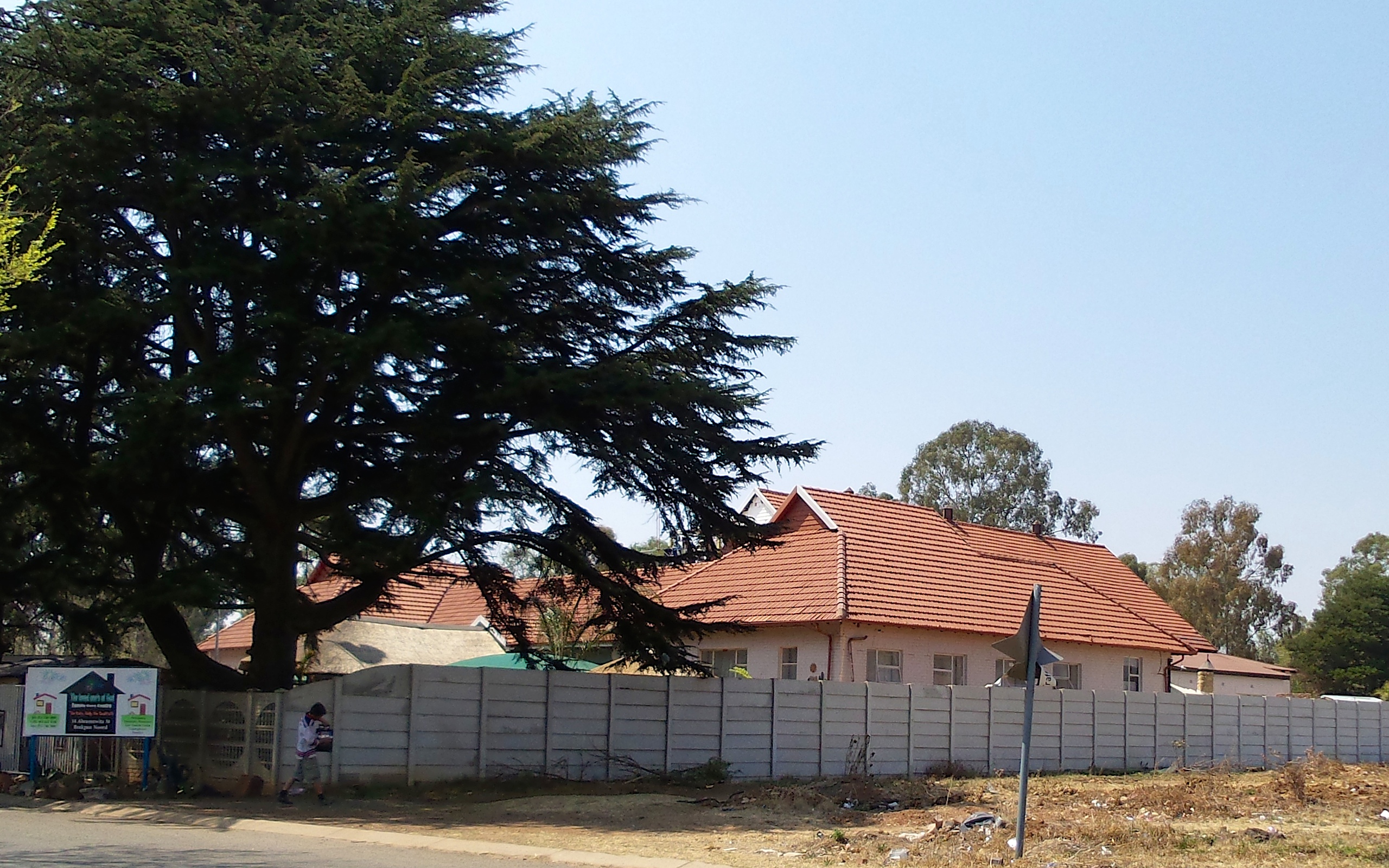|
Elijah Barayi
Elijah Barayi (15 June 1930 – 24 January 1994) was a South African trade union leader. Born in Cradock, Barayi hoped to study at the Fort Hare University, but his family were unable to afford tuition, so he instead became a clerk at the Department of Native Affairs. He joined the African National Congress (ANC) in 1952, and worked closely with James Calata. He participated in the Defiance Campaign, presenting himself at a local police station without papers after curfew, for which he was sentenced to one month in prison. In 1960, the ANC was banned, and Barayi was again arrested, and held for five months. Following release, he moved to Brakpan to escape police harassment, and found work in personnel at a gold mine. In 1973, he moved to a similar role in Carletonville, and there was elected as the chair of the mine's liaison committee. He attempted to use the role to oppose racial discrimination and underpayment, and was banned by management from standing for a second ... [...More Info...] [...Related Items...] OR: [Wikipedia] [Google] [Baidu] |
South African People
According to the 2022 census, the population of South Africa is about 62 million people of diverse origins, cultures, Languages of South Africa, languages, and Religion in South Africa, religions, with a majority being Black Africans. The South African National Census of 2022 was the most recent census held; the next will be in 2032. In 2011, Statistics South Africa counted 2.1 million foreigners in total. Reports suggest that is an underestimation. The real figure may be as high as five million, including some three million Demographics of Zimbabwe, Zimbabweans. History The earliest creatures that can be identified as human ancestors in South Africa are Australopithecine, australopithecines. The first evidence of this was a Taung Child, child's skull found in the Taung quarry site. This was in the modern day North West (South African province), North-West province. More Fossil, fossils australopithecines were found in limestone caves Sterkfontein, Swartkrans, and Kromdraai ... [...More Info...] [...Related Items...] OR: [Wikipedia] [Google] [Baidu] |
Cradock, Eastern Cape
Cradock, officially Nxuba, is a town in the Eastern Cape Province of South Africa, in the upper valley of the Great Fish River, by road northeast of Gqeberha. The town is the administrative seat of the Inxuba Yethemba Local Municipality in the Chris Hani District of the Eastern Cape. The town is named after John Cradock, governor of the Cape Colony in early 19th century and commander of the forces. Pre-colonial history For thousands of years San hunter-gatherers were the sole human inhabitants of southern Africa. About 2000 years BP the semi-nomadic Khoikhoi (or Khoekhoen or Khoikhoin) arrived with cattle, sheep and goats. These pastoralists migrated south towards the coast. Rock paintings and petroglyphs (engravings) remain as evidence of the first people who lived here. By the 4th century AD Bantu-speaking people had begun to migrate from central Africa down the east coast into southern Africa. The amaXhosa pressed further south to the banks of the Great Fish River whe ... [...More Info...] [...Related Items...] OR: [Wikipedia] [Google] [Baidu] |
Fort Hare University
The University of Fort Hare () is a public university in Alice, Eastern Cape, South Africa. It was a key institution of higher education for Africans from 1916 to 1959 when it offered a Western-style academic education to students from across sub-Saharan Africa, creating an African elite. Fort Hare alumni were part of many subsequent independence movements and governments of newly independent African countries. In 1959, the university was subsumed by the apartheid system, but it is now part of South Africa's post-apartheid public higher education system. It is the alma mater of well-known people including Nelson Mandela, Desmond Tutu, Robert Sobukwe, Oliver Tambo, and others. History Originally, Fort Hare was a British fort in the wars between British settlers and the Xhosa of the 19th century. Some of the ruins of the fort are still visible today, as well as graves of some of the British soldiers who died while on duty there. During the 1830s, the Lovedale Missionary In ... [...More Info...] [...Related Items...] OR: [Wikipedia] [Google] [Baidu] |
Department Of Native Affairs
Department may refer to: * Departmentalization, division of a larger organization into parts with specific responsibility Government and military *Department (administrative division), a geographical and administrative division within a country, for example: **Departments of Colombia, a grouping of municipalities **Departments of France, administrative divisions three levels below the national government **Departments of Honduras **Departments of Peru, name given to the subdivisions of Peru until 2002 **Departments of Uruguay *Department (United States Army), corps areas of the U.S. Army prior to World War I *Fire department, a public or private organization that provides emergency firefighting and rescue services *Ministry (government department), a specialized division of a government *Police department, a body empowered by the state to enforce the law * Department (naval) administrative/functional sub-unit of a ship's company. Other uses * ''Department'' (film), a 2012 Bollywoo ... [...More Info...] [...Related Items...] OR: [Wikipedia] [Google] [Baidu] |
African National Congress
The African National Congress (ANC) is a political party in South Africa. It originated as a liberation movement known for its opposition to apartheid and has governed the country since 1994, when the 1994 South African general election, first post-apartheid election resulted in Nelson Mandela being elected as President of South Africa. Cyril Ramaphosa, the incumbent national president, has served as president of the ANC since 18 December 2017. Founded on 8 January 1912 in Bloemfontein as the South African Native National Congress, the organisation was formed to advocate for the rights of Bantu peoples of South Africa, black South Africans. When the National Party (South Africa), National Party government came to power 1948 South African general election, in 1948, the ANC's central purpose became to oppose the new government's policy of institutionalised apartheid. To this end, its methods and means of organisation shifted; its adoption of the techniques of mass politics, and ... [...More Info...] [...Related Items...] OR: [Wikipedia] [Google] [Baidu] |
James Calata
James Arthur Calata OLG (1895 – 1983) was a South African priest and politician. He was the Secretary-General of the African National Congress from 1936 to 1949. He was appointed a canon of the Grahamstown Cathedral making him the first Black canon in the Anglican Church of Southern Africa. Early life James Arthur Calata was born in Debe Nek, near King William's Town in the Eastern Cape on 22 July 1895. His father, James was an uneducated farmer and a Presbyterian. His mother Eliza, reached Standard 4, practiced as a midwife and was an Anglican. He was educated at St Matthew's College in Keiskammahoek, from 1911 to 1914 and later worked as a teacher for a number of years. He married Miltha Mary Koboka in 1918, they went on to have three daughters. He was grandfather of Fort Calata who was also a politician. Career Calata became deacon in the Anglican Church in 1921, ordained priest in 1926, and worked briefly in Port Elizabeth, until he was sent to serve as a minister ... [...More Info...] [...Related Items...] OR: [Wikipedia] [Google] [Baidu] |
Brakpan
Brakpan is a mining town on the East Rand of Gauteng, South Africa, approximately 38 kilometres (23.6 mi) east of Johannesburg. History The name Brakpan comes from a small pan on a farm called Weltevreden, which was filled with very brackish water and was probably referred to as the "brakpan", and it was near this pan that the first settlement started. In 1888, a coal seam was discovered and a coal mine under the name of Brakpan Collieries was started. When a railway line was constructed from Germiston to Springs, Gauteng, Springs, Brakpan became one of the stations along the route. With gold fever running high on the Witwatersrand in the early years of the twentieth century, it was not long before gold was discovered. In 1905, Brakpan Mines Company sunk its first two gold mining shafts. One of its claims to fame was that it had the highest mine dump in the world at that time, above ground level. This was higher than any of the pyramids of Egypt except the Pyramid of Cheops. From ... [...More Info...] [...Related Items...] OR: [Wikipedia] [Google] [Baidu] |
Carletonville
Carletonville is a town in Gauteng and the seat of the Merafong City Local Municipality in the West Rand District Municipality in Gauteng, South Africa, just north of the richest gold-mining area in the world. At 3,749 m, Western Deep Levels holds the record for the world's deepest gold mine. History Developed by various mining companies from 1937 onwards, Carletonville was named after the long-serving mining director of Consolidated Gold Fields, Guy Carleton Jones, but was not officially incorporated until 1959. Upon reaching a population of 2000 1967, (mostly white inhabitants of the apartheid era) it became officially recognised and celebrated as a provincial town. There are several privately owned gold-mining township villages and contractor labour quarters established on mining ground owned by the various mining houses which operate in the area. The villages are located to the South of the R501 provincial road which forms the southern boundary of Carletonville. While the ... [...More Info...] [...Related Items...] OR: [Wikipedia] [Google] [Baidu] |
Cyril Ramaphosa
Matamela Cyril Ramaphosa (born 17 November 1952) is a South African businessman and politician serving as the 5th and current President of South Africa since 2018. A former Anti-Apartheid Movement, anti-apartheid activist and trade union leader, Ramaphosa is also the president of the African National Congress (ANC). Ramaphosa rose to national prominence as secretary general of South Africa's biggest and most powerful trade union, the National Union of Mineworkers (South Africa), National Union of Mineworkers. 48th National Conference of the African National Congress, In 1991, he was elected ANC secretary general under ANC president Nelson Mandela and became the ANC's chief negotiator during the Negotiations to end apartheid in South Africa, negotiations that ended apartheid. He was elected chairperson of the Constitutional Assembly after the country's 1994 South African general election, first fully democratic elections in 1994 and some observers believed that he was Mandela's ... [...More Info...] [...Related Items...] OR: [Wikipedia] [Google] [Baidu] |
National Union Of Mineworkers (South Africa)
The National Union of Mineworkers (NUM) is a mainly Mining industry of South Africa, mining industry related trade union, an organisation of workers with common goals through organised labour, in South Africa. With a membership of 300,000 , it is the largest affiliate of the Congress of South African Trade Unions (COSATU). History The union was founded in 1982 as a black mine workers union, on the initiative of the Council of Unions of South Africa. Its first leader was Cyril Ramaphosa, under whom it grew rapidly, winning bargaining recognition from the South African Chamber of Mines, Chamber of Mines in 1983. NUM campaigned successfully in the 1980s for the end of the job reservation system, a system which ensured that the best-paid jobs were allocated to whites. The union was a founding affiliate of the Congress of South African Trade Unions in 1985. In 2001, it absorbed the Construction and Allied Workers' Union, while in 2021 it absorbed the Liberated Metalworkers' Unio ... [...More Info...] [...Related Items...] OR: [Wikipedia] [Google] [Baidu] |
Congress Of South African Trade Unions
The Congress of South African Trade Unions (COSATU or Cosatu) is a trade union federation in South Africa. It was founded in 1985 and is the largest of the country's three main trade union federations, with 21 affiliated trade unions.One Union expelled, and seven Unions voluntarily suspended their participation in COSATU History Founding and early history On 30 November 1985, 33 unions met at the University of Natal for talks on forming a federation of trade unions. This followed four years of unity talks between competing unions and federations that were opposed to apartheid and were "committed to a non-racial, non-sexist and democratic South Africa." COSATU was officially established on 1 December 1985. Among the founding unions were the affiliates of the Federation of South African Trade Unions (FOSATU), the small National Federation of Workers, and some independent unions, notably the National Union of Mineworkers. Elijah Barayi was the organisation's first president an ... [...More Info...] [...Related Items...] OR: [Wikipedia] [Google] [Baidu] |
1930 Births
Events January * January 15 – The Moon moves into its nearest point to Earth, called perigee, at the same time as its fullest phase of the Lunar Cycle. This is the closest moon distance at in recent history, and the next one will be on January 1, 2257, at . * January 26 – The Indian National Congress declares this date as Independence Day, or as the day for Purna Swaraj (Complete Independence). * January 28 – The first patent for a field-effect transistor is granted in the United States, to Julius Edgar Lilienfeld. * January 30 – Pavel Molchanov launches a radiosonde from Pavlovsk, Saint Petersburg, Slutsk in the Soviet Union. February * February 10 – The Việt Nam Quốc Dân Đảng launch the Yên Bái mutiny in the hope of ending French Indochina, French colonial rule in Vietnam. * February 18 – While studying photographs taken in January, Clyde Tombaugh confirms the existence of Pluto, a celestial body considered a planet until redefined as a dwarf planet ... [...More Info...] [...Related Items...] OR: [Wikipedia] [Google] [Baidu] |





